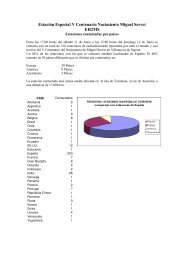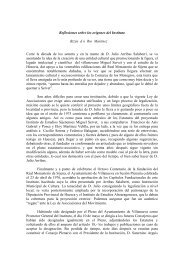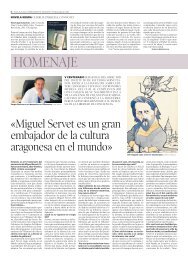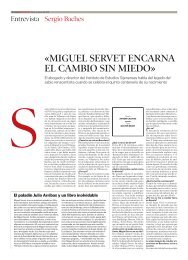New Page
New Page
New Page
Create successful ePaper yourself
Turn your PDF publications into a flip-book with our unique Google optimized e-Paper software.
Transylvania and that he should have sent it to Gyulafehérvár to be printed. (The publishing date of<br />
August 1568 is made probable by the fact that Refutatio propositionum Petri Melii, bound to which the<br />
greatest number of copies have survived, appeared at that time.) Pirnát also says that the style of the work,<br />
more verbose than in the other works of the Italian philosopher, also argues against the authorship of<br />
Fausto Sozzini. In addition, the method of the treatise, using logical and historical arguments, is also alien<br />
to the later works of Sozzini. Thus firmly denying that the author is Fausto Sozzini, he suggests Johann<br />
Sommer and/or Ferenc Dávid from among the Transylvanians as the author.<br />
On the other hand, since Lech Szczucki drew attention to the Warsaw copy, most of the specialists<br />
are of the opinion that the Transylvanian edition is the first publication of Fausto Sozzini's<br />
work.131 Szczucki's conclusions even further confirm the notion that the earlier version of the text is the<br />
one that Franciscus Iunius published in 1591. According to that view, this version was written much<br />
earlier, sometime in 1562-63 in Basle or in Zürich. Its existence would seem to be indicated most clearly<br />
by the dialogues of Bernardino Ochino, published in Basle in 1563, since these contain the argument that<br />
John the Apostle did not write his gospel against Ebion and Cerinthus. Then again, its existence is further<br />
proved by letters from the 1560s in which Fausto Sozzini asks his friends to send him the text. This text<br />
was then, somewhere in the late sixties, complemented with a dedication adjusted to the conditions in<br />
Transylvania and, after the stylistic changes of Celio Secundo Curione, was published in Transylvania.<br />
Opinions, however, differ on the date of the Gyulafehérvár edition. Marchetti holds that the first<br />
edition was published bound together with Refutatio propositionum Petri Melii and because this work<br />
contains the theses intended for the Synod at Torda, formulated at Várad on August 22, 1568, it was, he<br />
believes, published after August 22, 1568. The fact that the publication does not respond to the Synod at<br />
Torda would indicate the terminus ante quem (November 14). According to Marchetti, printing the work<br />
in the autumn of 1568 was made actual by the fact that Fausto Sozzini was expected in Transylvania for<br />
1569. Thus he also can explain why Explicatio did not get into De falsa et vera published in July 1569:<br />
obviously arriving too late, there was no time for it to be included in that book.<br />
Giving no closer date in the first +report", Lech Szczucki dated the work to 1567-68. Later he<br />
would move this date nearer to 1567.132 For he noticed that Jan Lasicki wrote the following to Béze on<br />
April 20, 1568 from Heidelberg: +Let the Lord give you, the interpreter of the Scripture, the same spirit<br />
filled with which the Apostle John wrote his gospel about Christ's eternal divinity. Ours deny this and say<br />
that the entire first chapter of John's gospel is about the Man Christ. I have amply shown how truly they<br />
teach this in my writing that I wrote against Grzegorz Pawel, the prince of the Sarmata heretics."133 The<br />
Polish scholar assumes that in this lost work of his, Lasicki differed with the Polish translation based on<br />
the version of Explicatio issued at Gyulafehérvár and which appeared after the Latin version, according to<br />
a later statement of Fausto Sozzini. Thus the Latin text naturally must have left the printing press<br />
considerably earlier.<br />
Antonio Rotondo134 starts from another observation, making use of the following passage in the<br />
preface dated to August 1568 of the work entitled De aeterno dei filio of Josias Simler, a theologian from<br />
Zürich: +This book of mine might have been published perhaps in a clearer and ampler form if, due to the<br />
great distance, on the one hand, and, on the other, the shrewdness of the enemy because they hardly suffer<br />
that their works fall into our hands, the books through which these impious doctrines are propagated had<br />
not come to me after long delays. For my three books on the eternal son had been printed when I received<br />
at last Ferenc Dávid's book against Péter Melius, and certain writings by Petrus Gonesius, and an<br />
anonymous explication of the first chapter of John's gospel, a hand-copied part of which a good man had<br />
sent me previously."135 According to Rotondo, since book one of the work contains the refusal of the<br />
Lelio Sozzini version, the anonymous interpretation of John's gospel can be the work of Fausto Sozzini<br />
only. Simler's work certainly left the printing shop in August 1568 since in one of his letters early in<br />
September he mentions it as just published. We can add that Bullinger sent the work, complete and ready,<br />
to Béze on August 24, 1568.136 So, according to this line of reasoning, Explicatio must have been<br />
44







